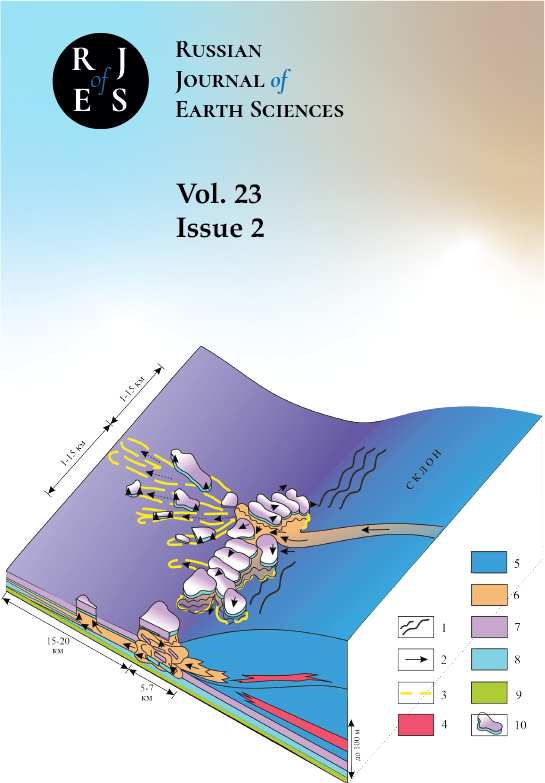Институт физики Земли им. О.Ю. Шмидта Российской академии наук
Москва, Россия
Россия
Россия
Россия
ГРНТИ 37.01 Общие вопросы геофизики
ГРНТИ 37.15 Геомагнетизм и высокие слои атмосферы
ГРНТИ 37.25 Океанология
ГРНТИ 37.31 Физика Земли
ГРНТИ 38.01 Общие вопросы геологии
BISAC SCI SCIENCE
The paper describes the course of the COVID-19 pandemic using a combination of mathematical statistics and discrete mathematical analysis (DMA) methods. The method of regression derivatives and FCARS algorithm as components of DMA will be for the first time tested outside of geophysics problems. The algorithm is applied to time series of the number of new cases of COVID-19 infections per day for some regions of Russia and the Republic of Austria. This allowed to assess the nature and anomalies of pandemic spread as well as restrictive measures and decisions taken in terms of the administration of countries and territories. It was shown that these methods can be used to identify time intervals of change in the nature of the incidence rate and areas with the most severe course of the epidemic. This made it possible to identify the most significant restrictive measures that allowed to reduce the growth of the disease.
COVID-19, DMA, statistics, data analysis
1. Adjei, S., K. Hong, N.-A. M. Molinari, L. Bull-Otterson, U. A. Ajani, A. V. Gundlapalli, A. M. Harris, J. Hsu, S. S. Kadri, J. Starnes, K. Yeoman, and T. K. Boehmer (2022), Mortality Risk Among Patients Hospitalized Primarily for COVID-19 During the Omicron and Delta Variant Pandemic Periods - United States, April 2020 - June 2022, MMWR. Morbidity and Mortality Weekly Report, 71(37), 1182-1189, doihttps://doi.org/10.15585/mmwr.mm7137a4.
2. Agayan, S. M., Sh. R. Bogoutdinov, and R. I. Krasnoperov (2018), Short introduction into DMA, Russian Journal of Earth Sciences, 18(2), ES2001, doihttps://doi.org/10.2205/2018es000618. EDN: https://elibrary.ru/XSJQUP
3. Agayan, S. M., Sh. R. Bogoutdinov, D. A. Kamaev, and M. N. Dobrovolsky (2019a), Stochastic trends based on fuzzy mathematics, Chebyshevskii Sbornik, 20(3), 92-106, doihttps://doi.org/10.22405/2226-8383-2019-20-3-92-106, (in Russian). EDN: https://elibrary.ru/EUJHKZ
4. Agayan, S. M., A. A. Soloviev, Sh. R. Bogoutdinov, and Yu. I. Nikolova (2019b), Regression derivatives and their application in the study of geomagnetic jerks, Geomagnetism and Aeronomy, 59(3), 359-367, doihttps://doi.org/10.1134/s0016793219030022. EDN: https://elibrary.ru/TVQVWR
5. Agayan, S. M., Sh. R. Bogoutdinov, M. N. Dobrovolsky, O. V. Ivanchenko, and D. A. Kamaev (2021), Regression differentiation and regression integration of finite series, Chebyshevskii Sbornik, 22(2), 27-47, doihttps://doi.org/10.22405/2226-8383-2021-22-2-27-47, (in Russian). EDN: https://elibrary.ru/VTOWON
6. Aurambout, J.-P., C. Pettit, and H. Lewis (2008), Virtual Globes: the Next GIS?, in Lecture Notes in Geoinformation and Cartography, pp. 509-532, Springer Berlin Heidelberg, doihttps://doi.org/10.1007/978-3-540-69168-6_25.
7. Dzeboev, B. A., A. A. Odintsova, A. I. Rybkina, and B. V. Dzeranov (2022), Assessment of the influence of astronomical cyclicity on sedimentation processes in the Eastern Paratethys based on paleomagnetic measurements using Discrete Mathematical Analysis, Applied Sciences, 12(2), 580, doihttps://doi.org/10.3390/app12020580. EDN: https://elibrary.ru/KYEGFN
8. GIBDD (2023), Information about the indicators of the state of road safety, http://stat.gibdd.ru/.
9. GitHub (2023), CSSEGISandData/COVID-19: Novel Coronavirus (COVID-19) Cases, provided by JHU CSSE, http s://github.com/CSSEGISandData/COVID-19.
10. Gvishiani, A. D. (2019), Interdisciplinary Arctic Studies and System Analysis, in V International Arctic Forum "Arctic: Territory of Dialogue" on 9-10 April, St. Petersburg, Russia, (in Russian).
11. Gvishiani, A. D., S. M. Agayan, Sh. R. Bogoutdinov, A. V. Ledenev, Z. Zlotniki, and Z. Bonnin (2003), Mathematical Methods of Geoinformatics. II. Fuzzy-Logic Algorithms in the Problems of Abnormality Separation in Time Series, Cybernetics and Systems Analysis, 39(4), 555-563, doihttps://doi.org/10.1023/b:casa.0000003505.56410.4f. EDN: https://elibrary.ru/LHZMEP
12. Gvishiani, A. D., S. M. Agayan, and Sh. R. Bogoutdinov (2008), Fuzzy recognition of anomalies in time series, Doklady Earth Sciences, 421(1), 838-842, doihttps://doi.org/10.1134/s1028334x08050292. EDN: https://elibrary.ru/LKXKYV
13. Huang, C., Y. Wang, X. Li, et al. (2020), Clinical features of patients infected with 2019 novel coronavirus in Wuhan, China, The Lancet, 395(10223), 497-506, doihttps://doi.org/10.1016/s0140-6736(20)30183-5.
14. Kolmogorov, A. N., and S. V. Fomin (2004), Elements of the Theory of Functions and Functional Analysis, 7th ed., Fizmatlit, Moscow, (in Russian).
15. Odintsova, A., A. Rybkina, J. Nikolova, and A. Korolkova (2020), GIS Project ROSA: FAIR Principles in the Petroleum Industry, Data Science Journal, 19(1), 13, doihttps://doi.org/10.5334/dsj-2020-013. EDN: https://elibrary.ru/BHNJOQ
16. ORBUS Web (2019), http://data.sph.gcras.ru/OrbusWeb.html?/COVID-19.
17. Rospotrebnadzor (2023), Answers to frequently asked questions about coronavirus infection COVID-19, http://86.rospotrebnadzor.ru/territorialnye-otdely/ug/otvety-na-chasto-zadavaemye-voprosy-po-koronavirusnoj-infekcii-covid-19.
18. Rossiyskaya Gazeta (2022), Preliminary results of the All-Russian Population Census, https://rg.ru/2022/05/30/predvaritelnye-itogi-vserossijskoj-perepisi-naseleniia.html.
19. Saxena, R., M. Jadeja, and V. Bhateja (2022), Exploring Susceptible-Infectious-Recovered (SIR) Model for COVID-19 Investigation, 53 pp., Springer Nature Singapore, doihttps://doi.org/10.1007/978-981-19-4175-7.
20. Sklyarov, B. A. (2022), Research data and conclusions pertaining to the omicron strain of coronavirus (COVID-19), International Journal of Humanities and Natural Sciences, pp. 102-105, doihttps://doi.org/10.24412/2500-1000-2022-5-1-102-105, (in Russian). EDN: https://elibrary.ru/WNMINM
21. Soloviev, A. A., A. I. Gorshkov, and A. A. Soloviev (2016), Application of the data on the lithospheric magnetic anomalies in the problem of recognizing the earthquake prone areas, Izvestiya, Physics of the Solid Earth, 52(6), 803-809, doihttps://doi.org/10.1134/s1069351316050141. EDN: https://elibrary.ru/XFOFXJ
22. World Health Organization (2019), Public Health and Social Measures, https://www.who.int/emergencies/diseases/novel-coronavirus-2019/phsm.
23. Yandex DataLens (2023), Coronavirus. Dashboard and data.

















